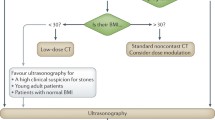Abstract
This study was done to identify the value of the commonly performed investigations available for identifying urinary stone disease, namely X-ray of the kidney, ureter and bladder (KUB) regions and ultrasound scan (USS) to recognize stones in patients suspected to have the disease. Two hundred patients who attended the stone clinic with symptoms suggestive of urinary stone disease and had either stone retrieved or have been followed up for minimum of 6 months were interviewed. The final opinion on stone disease was made after follow-up to assess the efficacy of the initial opinion based on the plain X-ray KUB or USS. The patients were classified as proved stone patients only after retrieval of stones. The efficacy of the initial screening investigation was assessed to calculate the specificity and sensitivity of the two modalities of investigation. Of the 200 patients studied, all had plain X-ray KUB. Only 166 patients had USS for recognizing stones in the urinary tract; 74 patients showed positive evidence of stones either by X-ray or USS. The findings of the two modalities of investigation are given below. Number of X-rays done, 200; number positive, 24; proved positive, 24 (stone retrieved); proved negative, 0; number negative, 176; proved positive, 32 (stone retrieved); proved negative, 144; number of USS done, 166; number positive, 120; proved positive, 50 (stone retrieved); proved negative, 70; number negative, 46; proved positive, 14 (stone retrieved); proved negative, 32. USS showed back presence effects in 62 patients. Of these, 12% showed stones in the ureter, whereas the rest did not show evidence of stones. Those selected as positive stones finally had either passed stones or had PCNL, URS, cystolithotripsy or open surgery or were put on high-dose chemotherapy. Forty-six patients who had no ROS in KUB and no stones in USS passed stones subsequently. It is concluded that the plain both X-ray KUB and USS should be performed in patients with suspected stone disease for identifying stone disease and also to exclude other pathology which may produce similar urinary symptoms.


Similar content being viewed by others
References
Levine JA, Neitlich J, Verga M, Dalrymple N, Smith RC (1997) Ureteral calculi in patients with flank pain: correlation of plain radiography with unenhanced helical CT. Radiology. 204:27–31
Chu G, Rosenfield AT, Anderson K, Scout L, Smith RC (1999) Sensitivity and value of digital CT scout radiography for detecting ureteral stones in patients with ureterolithiasis diagnosed on unenhanced CT. Am J Roentgenol 173:417–423
Elbahnasy AM, Clayman RV, Shalhav AL, Hoenig DM, Chandhoke P, Lingeman JE, Denstedt JD, Kahn R, Assimos DG, Nakada SY (1998) Lower-pole calyceal clearance after shockwave lithotripsy, percutaneous nephrolithotomy and flexible ureteroscopy: impact of radiographic spatial anatomy. J Endourol 12:113–119
Yilmaz S, Sindel T, Arslan G, Ozkaynak C, Karaali K, Kabaalioglu A, Luleci E (1998) Renal colic: comparison of spiral CT, US and IVU in the detection of ureteral calculi. Eur Radiol 8:212–217
Wang LJ, Ng CJ, Chen JC, Chin TF, Wong YC (2004) Diagnosis of acute flank pain caused by ureteral stones: value of combined direct and indirect signs on IVU and unenhanced helical CT. Eur Radiol 14:1634–1640
Pepe P, Motta L, Pennisi M, Aragona F (2005) Functional evaluation of the urinary tract by color-Doppler ultrasonography (CDU) in 100 patients with renal colic. Eur J Radiol 53:131–135
Kartal M, Eray O, Erdogru T, Yilmaz S (2006) Prospective validation of a current algorithm including bedside US performed by emergency physicians for patients with acute flank pain suspected for renal colic. Emerg Med J 23:341–344
Mitterberger M, Pinggera GM, Maier E, Neuwirt H, Neururer R, Pallwein L, Gradl J, Bartsch G, Strasser H, Frauscher F (2007) Value of 3-dimensional transrectal/transvaginal sonography in diagnosis of distal ureteral calculi. J Ultrasound Med 26:19–27
Yoon DY, Bae SH, Choi CS (2000) Transrectal ultrasonography of distal ureteral calculi: comparison with intravenous urography. J Ultrasound Med 19:271–275
Yang JM, Yang SH, Huang WC (2005) Transvaginal sonography in the assessment of distal ureteral calculi. Ultrasound Obstet Gynecol 26:658–662
Author information
Authors and Affiliations
Corresponding author
Additional information
11th international symposium on urolithiasis, Nice, France, 2–5 September 2008 Urological Research (2008) 36:157–232. doi:10.1007/s00240-008-0145-5. http://www.springerlink.com/content/x263655772684210/fulltext.pdf.
Rights and permissions
About this article
Cite this article
Varma, G., Nair, N., Salim, A. et al. Investigations for recognizing urinary stone. Urol Res 37, 349–352 (2009). https://doi.org/10.1007/s00240-009-0219-z
Received:
Accepted:
Published:
Issue Date:
DOI: https://doi.org/10.1007/s00240-009-0219-z




